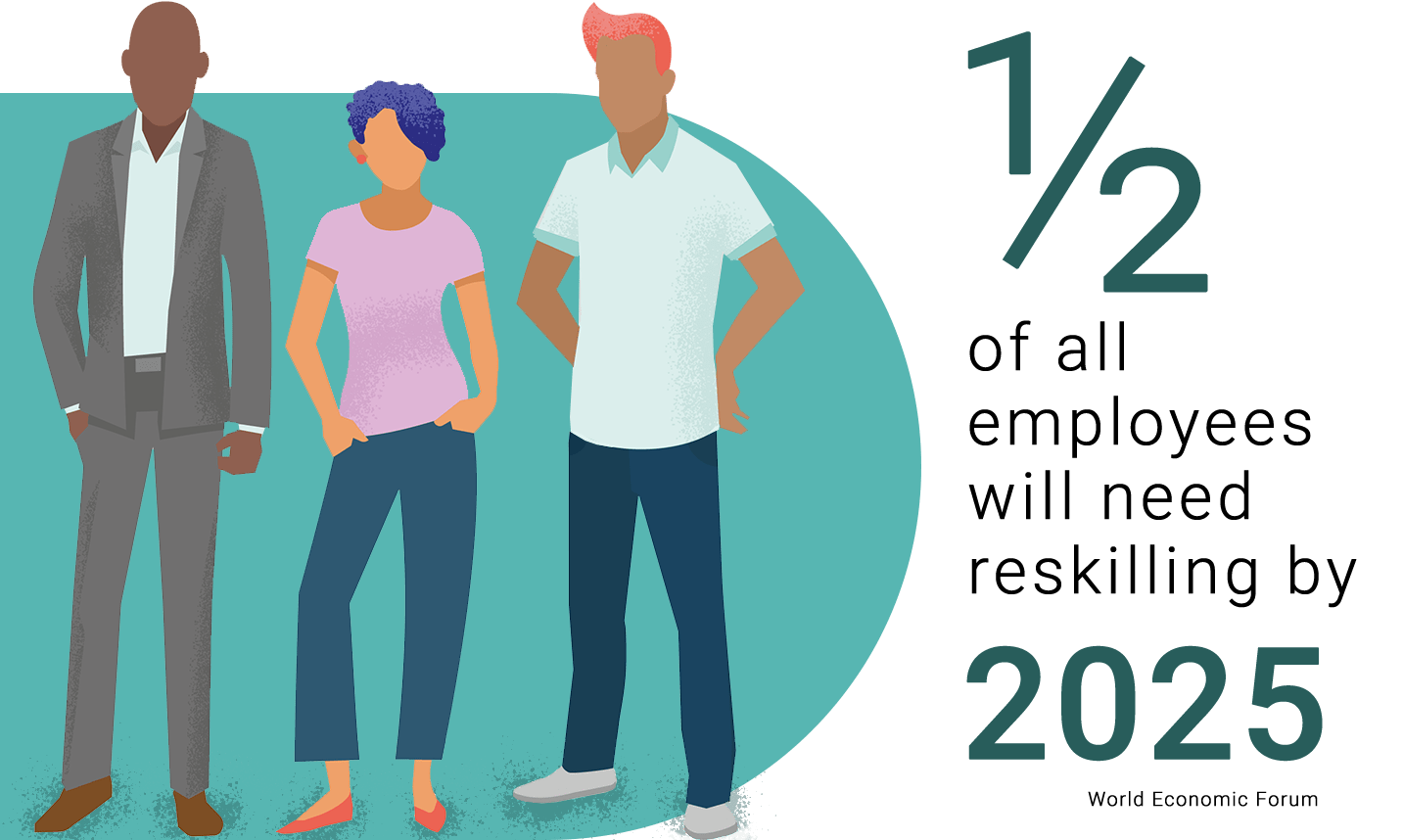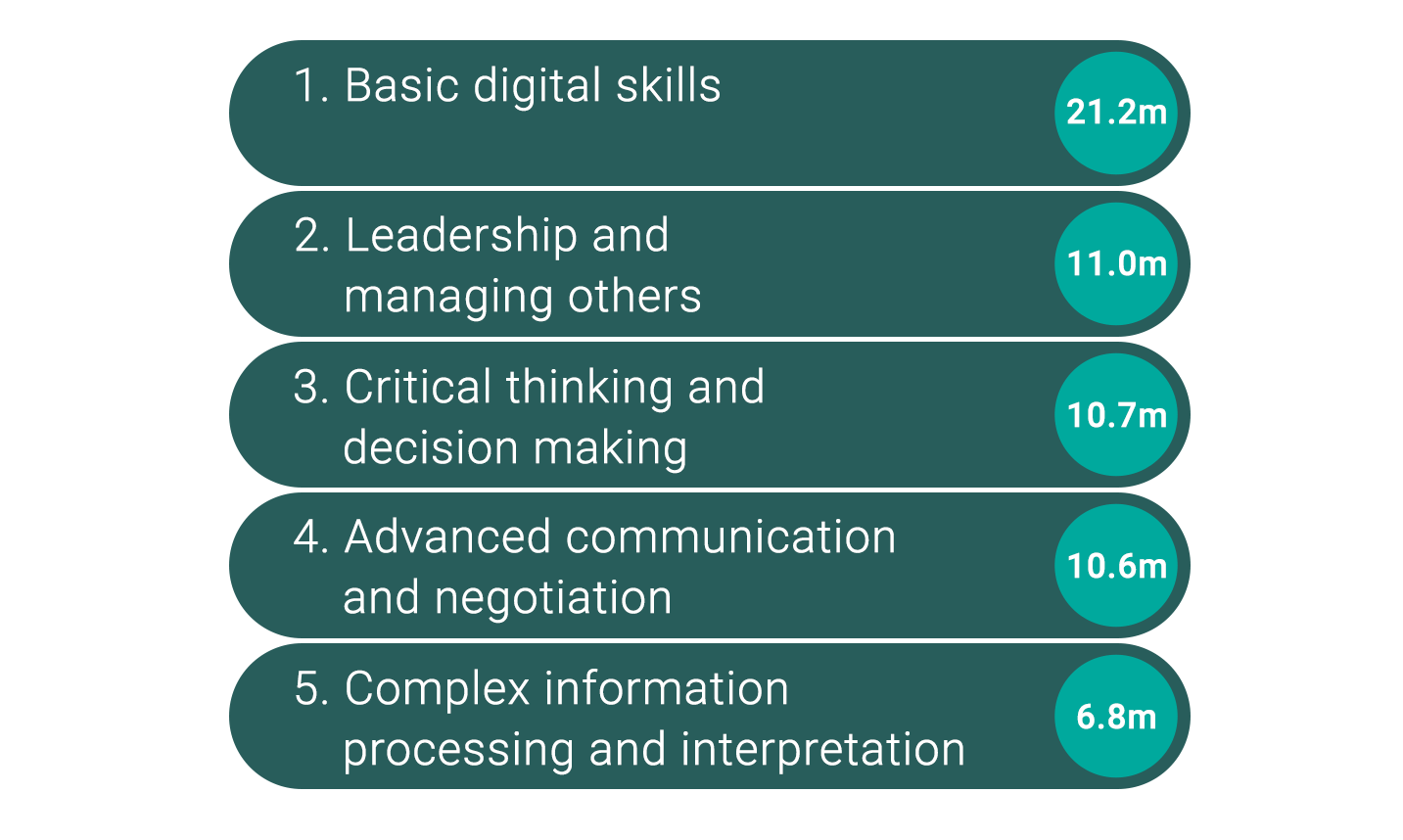Estimated reading time: 7 minutes
Skills are a hot topic right now, and no doubt you’ve come across the terms reskilling and upskilling, at least in passing. Why are they capturing the interest of workplace learning specialists, and what exactly do they mean? In this article, we’ll provide an overview of their definitions, discuss their importance to business aims, and give you some practical tips to bring skills to the centre of your learning strategy.
Every year, Donald H Taylor, influential leader in the fields of workplace learning and learning technologies, conducts his L&D Global Sentiment Survey, asking over 3,000 Learning and Development (L&D) professionals worldwide just one question: What will be hot in workplace learning in the next year? In 2021, ‘reskilling/upskilling’ flew to the top of the leaderboard, not having featured at all in previous years. This option also took an unusually large share of the vote, suggesting that it’s something at the forefront of many people’s minds at the moment.
So what exactly are the definitions of reskilling and upskilling?
- Reskilling means learning new skills in order to do a different job or role, usually within the same organisation. This is critical for employers if they need to redeploy staff.
- Upskilling means learning new skills to grow in your current role, to fulfil a specific organisational need.
You might be reading these definitions and thinking this just sounds like what L&D should be doing every day – but as the MindTools 2021 benchmark report shows, a great many organisations aren’t making a successful link between learning and performance.
Turbulent times

When organisations are dealing with challenging circumstances, both upskilling and reskilling are even more important than usual. Businesses are running on tight margins, possibly with reduced staff numbers due to redundancies, and making the most of every employee’s contribution is critical. Small improvements in productivity can have a huge impact on the organisation as a whole – and ensuring employees are upskilled to achieve this should be the role of L&D.
Redeploying staff to fill vacancies elsewhere in a business is also top of the agenda when times are difficult; recruitment is notoriously expensive, so redirecting resources becomes the name of the game. This is where short-term reskilling comes in, but that requires managers, HR and L&D to work together to identify employees with adjacent skills who are willing and able to switch roles – and then provide focussed learning opportunities to ensure they succeed.
Closing the skills gap

Regardless of the challenges your organisation is facing, they need to bridge the gap between employees’ current skills and the capabilities they need to fulfil their potential. That potential could be in their current role or elsewhere in the company, but unless it’s identified and nurtured, opportunities are being wasted. Is your L&D function set up to do this?
As Simon Gibson, Future Skills & Career Lead at Direct Line Group pointed out on the Learning and Development Podcast, training and learning are different things. Unless the learning opportunities you offer to employees are designed to address the skills gaps they have, they won’t be effective in improving organisational outcomes. This doesn’t mean you can’t use face-to-face training courses or elearning – but it does mean that careful analysis of what’s actually happening on the ground is an absolute must. It’s also critical to consider how the skills can be developed most effectively, whether that’s through on-the-job learning, coaching, microlearning opportunities or even simple job aids.
We often hear about developing a ‘learning culture’. This phrase can be overused, but don’t dismiss it entirely. If your organisation is focussed on finding out what needs to be done to achieve key aims, identifying the skills people need to develop in order to get there, and providing opportunities to hone those skills – well, that’s a learning culture. It needn’t cost you the earth, either.
While it may be tempting to purchase a fully-loaded, state-of-the-art Learning Experience Platform (LXP), don’t fall into the trap of overloading employees with a massive library of content. If you’re not careful, this approach could actually waste time and lower their productivity. You’re far better off investing the time in pinpointing those skills gaps and providing focussed interventions – and you’ll probably save money, too.
The power of data

So how exactly are you going to identify which skills you need, and who needs them? Chances are, your organisation is already collecting data that would provide the perfect starting point. Ultimately, any information you have about progress towards business objectives could be useful, but in many cases could be difficult to access. Start with a small, measurable target – this could be lead conversion, customer satisfaction after a support call, error rate for a process, or employee KPIs. If the measure falls short of the ideal, look for the skills team members need to improve performance, and plan how to develop them.
It’s important to note here that you also need to be on the lookout for any organisational factors that may be holding them back; for example, there’s little point investing in customer communication training for support technicians if the product they’re supporting has an unreasonable failure rate due to manufacturing problems. Data can help you identify these kinds of systemic issues that may be going undetected.
Another approach you could take is a full-scale skills gap analysis for all employees, administering a detailed assessment to identify their individual strengths and weaknesses. This can be time-consuming and generates an enormous amount of data (how are your own data analysis skills?), but can be invaluable for larger organisations in particular. It can also highlight employees who have skills (or the potential to develop them quickly) that are required in other teams or departments – giving you a headstart when it comes to redeployment and reskilling.
Planning ahead

It’s not just the short-term future of your organisation that will be affected by skills gaps. According to the World Economic Forum, half of all employees will need reskilling by 2025, with these areas of greatest importance:
- Critical thinking and analysis
- Problem-solving
- Self-management
- Working with people
- Management and communication of activities
Modelling from the McKinsey Global Institute suggests that, by 2030, millions of UK workers could be underskilled in the following areas:

From looking at these figures, it’s clear that employers need to invest in upskilling workers now to avoid being left behind in the next decade. Increasing prevalence of automation over the coming years will also have an undeniable effect. Providing opportunities for upskilling and reskilling is also likely to become a necessity for companies looking to attract and retain the best talent. L&D, in conversation with business leaders, can have a big impact on the success of organisations (and individual employees) in facing these challenges; being proactive about your learning strategy has never been so important.
Are reskilling and upskilling at the top of your agenda? What challenges have you faced with skills gaps in the workplace, and what skill types do you predict will become ever more critical in your organisation over the next decade? Let us know your thoughts below.


0 Comments